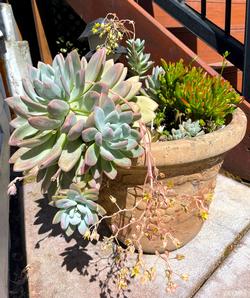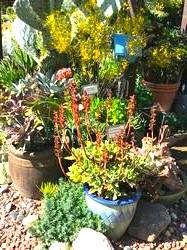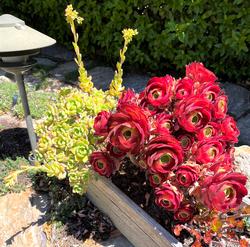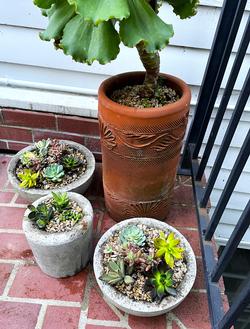Fall 2023
Small Spaces Gardening: Growing Succulents in Containers
by David George

Courtesy David George.
Succulents are popular patio container or indoor plants in Contra Costa County. Many are easy to grow in shady or dry conditions, which often challenge other container plants. Over 10,000 plant species in the world are considered succulents, and thrive in diverse climates such as humid coastal zones, hot deserts, and cold Alpine regions. They comprise about 3% of the world’s flowering plants and boast unusual leaf shapes and colors. And they are lovely when grouped together as accents on your patio or deck. Are you ready to grow your own succulent container garden? Let’s get started!

Courtesy UCANR.
If you intend to grow your new succulents on a patio or deck, most will thrive in locations that receive morning sun followed by afternoon shade. If planting indoors, choose a bright area in your home near a window but shaded from direct sunlight. Most outdoor succulents prefer mild temperatures between 50 and 85 degrees. Some can be kept outside, even below 40 degrees, if they are near your home or against a sunny wall. Cover them in breathable fabric or bring them indoors if a hard frost or freeze is in the forecast. It is also best to protect succulents from heavy rains as they will rot in soggy soil. A fabric shade can protect them from hot sunshine.
Some species grow and flower during hot months, then go dormant during colder months, while others grow during mild California winters and go dormant during summer (they all grow in spring and fall). Popular summer growers and bloomers are Sempervivums, Echeverias, and Agaves. Some winter growers to consider for our area are Aeoniums, Kalanchoes, and Sedums. For a good discussion of succulent dormancy and a list of choices and photos, visit https://succulentsbox.com/blogs/blog/succulent-dormancy-101 .

Courtesy David George.
Succulents typically have shallow roots, so they don't need deep containers, but they can spread laterally to fill a planter. If planted in a pot, glazed containers retain soil moisture better than terracotta. It's also fun to plant them in unusual containers like bonsai dishes, wheelbarrows, old shoes, hanging baskets, wine barrels, pumpkins, or indoor terrariums. Make sure the bottoms of your outdoor containers have one large or several smaller drain holes.
Plant succulents in soil that drains well. Use a specialty cactus and succulent or palm soil mix, or mix perlite in with commercial potting soil. Coarse sand and pumice can also be added to boost drainage. Periodically check the bottom drain holes for blockages. You can use decorative pebbles or small rocks as top coatings to hold soil in the pot and make it look attractive year-round.

Courtesy David George.
Succulents grown in containers need occasional fertilizing during their growing season but none when they are dormant. A slow-release fertilizer will feed your plants for 3 to 4 months. Succulents store ample water in their leaves, stems, and roots. Don’t overwater them, especially indoors. Periodically add water to outdoor containers, then let the soil dry out before watering again. Watering every week or two during summertime is sufficient for summer growers. During the dormant season,
a spritz of water once a month is beneficial for succulent plants in pots that are placed outdoors or indoors in order to keep the soil alive and healthy.
Succulents are easy to propagate. Leaves break off easily or you can carefully separate new “pups” (offsets) from their mother plant. Before planting, let the break callus over for a week, then plant near the soil surface or just lay a leaf on its side on the soil. Roots will develop within a few weeks.
Your succulents will thrive and delight you for years to come, producing attractive foliage, flowers, and interesting shapes and colors. For more information about succulents, check out the UC ANR online list of succulent resources at: https://acmg.ucanr.edu/Over_the_Fence/succulents/ .

Courtesy UCANR.





